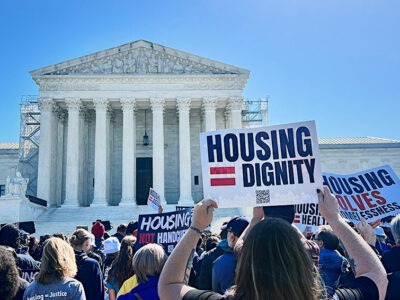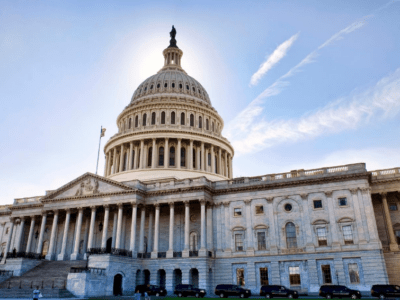Since 2011, Community Solutions has led Built for Zero, a movement of 84 cities and counties that are proving it’s possible to drive — and sustain — population-level reductions in homelessness. By implementing a data-driven approach:
- 13 communities have ended veteran or chronic homelessness, achieving a milestone known as functional zero;
- 48 communities have driven a measurable reduction in homelessness for at least one population; and
- 79 communities have achieved quality real-time data, enabling them to know everybody experiencing homelessness by name, in real time and with quantitative reliability — the foundation for achieving results.
Ending homelessness is going to take the dedication and commitment of our federal lawmakers. The election of a new administration provides the opportunity to renew our nation’s commitment to reducing and ending homelessness.
Our work to support communities in driving and sustaining reductions in homelessness has surfaced five priority policy recommendations that would catalyze results nationally. These include:
- Implement a shared aim and a clear measurement framework for sustainably ending homelessness
- Require quality real-time data on homelessness
- Finish the job of ending veteran homelessness
- Act on homelessness as a public health crisis
- End homelessness in rural America
Policy Memo: Priorities for Reducing and Ending Homelessness
Since 2011, Community Solutions has led Built for Zero, a movement of 84 cities and counties that are proving it’s possible to drive — and sustain — population-level reductions in homelessness. By implementing a data-driven approach:
- 13 communities have ended veteran or chronic homelessness, achieving a milestone known as functional zero;
- 48 communities have driven a measurable reduction in homelessness for at least one population; and
- 79 communities have achieved quality real-time data, enabling them to know everybody experiencing homelessness by name, in real time and with quantitative reliability — the foundation for achieving results.
Prior to Built for Zero, the team led the 100,000 Homes Campaign, which helped participating communities house more than 105,000 of the most medically vulnerable homeless Americans in under four years. Throughout this initiative, the team worked closely with the Obama Administration to excel in local, cross-agency implementation.
Our work to support communities in driving and sustaining reductions in homelessness has surfaced five priority policy recommendations that would catalyze results nationally. We strongly agree with proposals that others have put forth to increase federal housing resources. That said, the changes we propose are focused on improving the implementation of existing resources to achieve measurable, sustainable reductions in homelessness. Because these recommendations have been tested and refined across the country, the majority could be implemented quickly and without substantial new federal spending:
- Implement a shared aim and a clear measurement framework for sustainably ending homelessness
- Require quality real-time data on homelessness
- Finish the job of ending veteran homelessness
- Act on homelessness as a public health crisis
- End homelessness in rural America
1. IMPLEMENT A SHARED FRAMEWORK AND METRICS FOR SUSTAINABLY ENDING HOMELESSNESS
End State
A shared accountability framework is in place to guide communities in measuring an equitable end to homelessness that is:
- A measure of a population-level end state (how many people remain homeless, disaggregated by race), not outputs, strategies or behaviors
- Objectively measurable across contexts without discretionary judgment of actors
- Measurable in real time, over time like public health data
- Easily understood at any time to enable action and ongoing improvement
Rationale
The foundation for sustained, population-level change is clear accountability, which requires clarity on what success looks like and a simple, transparent and objective standard for measuring progress toward that aim at any given time.
Current federal benchmarks for measuring an end to homelessness are extremely complicated, inconsistent across populations, and often measure behaviors rather than outcomes. While these benchmarks have prompted some communities to adopt important behaviors like Housing First, their bureaucratic opacity has made meaningful accountability for sustained population level reductions in homelessness almost impossible.
Actions
In the first 100 days:
- Adopt Built for Zero’s tested and straightforward definition for ending and sustaining an end to veteran homelessness as a rigorous shared national standard.
- Functional zero definition: A community has ended veteran homelessness when it reaches and sustains a threshold where fewer veterans are experiencing homelessness than can be routinely housed in a month.
- Maintain the current federal definition for ending chronic homelessness, which is clear and objectively measurable.
Subsequent actions:
- Develop and disseminate similarly clear measurement frameworks for ending family, youth, single adult and all homelessness which meet the following criteria:
- Population-level and equity-specific
- Objectively measurable across contexts
- Simple and easily assessed
- Measurable in real time, over time
- Retool the NOFA competition, and other incentive structures, to align with, and drive accountability for these end state measures
2. REQUIRE QUALITY REAL-TIME DATA ON HOMELESSNESS
End State
All communities working to end homelessness must have quality by-name data, meaning a comprehensive accounting of every person experiencing homelessness locally, regardless of sheltered or unsheltered status, updated at least monthly. For Built for Zero communities, this level of data quality has been a singular gamechanger, enabling them to track and respond to the number of people experiencing homelessness, month over month, with a high degree of adaptive specificity.
Rationale
You cannot solve a problem you cannot fully see at both the aggregate and individual levels. But our government currently requires communities to collect only aggregate, estimated information on the number of people experiencing homelessness in their jurisdictions, and just once a year. If our line of sight into COVID-19 case rates was anonymous and only annual, we would have no hope of mounting a meaningful response. We cannot expect to drive meaningful reductions in a similarly dynamic problem like homelessness without comprehensive, real-time, person-specific data.
79 Built for Zero communities have achieved comprehensive, real-time, by-name data on every one of their neighbors experiencing homelessness. This enables local teams to:
- Understand precisely who is experiencing homelessness and more strategically triage and optimize existing resources
- Zoom out to understand how homelessness is evolving across a geography and where new protocols and system changes could have the largest effect
- More clearly map the resources required to achieve population-level reductions and target advocacy efforts with local, state and federal governments
Actions
In the first 100 days:
- Prioritize HUD funding that strengthens the data infrastructure of local Coordinated Entry Systems, which also enables collaboration with the Centers for Disease Control and Prevention.
- Reform HMIS by modernizing the statute to meet community data collection and use needs and cross system data sharing, and open the technology to meaningful market competition
Subsequent actions:
- Develop homelessness data standards and reporting requirements as part of the Public Health Data Modernization Act
- Update the Federal Notice of Funding Availability applications. Beginning in 2022, Federal Notice of Funding Availability (NOFA) applications should link scoring to the presence of infrastructure and the data reporting capability necessary to achieve and accurately monitor and report on rates of homelessness in real time.
3. FINISH THE JOB OF ENDING VETERAN HOMELESSNESS
End State
Every community has the resources and implementation vehicle to sustainably end veteran homelessness. The path has been cleared on last mile obstacles to progress, including but not limited to VA’s Grant and Per Diem Program. Local VAMCs are accountable for achieving and sustaining this outcome in their regions.
Rationale
As a result of the Obama administration’s commitment to ending veteran homelessness, our nation has made incredible progress toward that goal. With the leadership of the Biden administration, it is time to take veteran homelessness to zero. To achieve this requires clearing the final obstacles and fully deploying our existing resources.
One of the critical resources at our disposal is the Grant and Per Diem program, funded by the U.S. Department of Veterans Affairs (VA), which pays for a large number of service-intensive transitional housing programs on a per diem basis. The program thus inadvertently encourages protracted stays in shelter or transitional housing, often trapping veterans in homelessness for years in the very programs positioned to link them to permanent housing in a matter of weeks. Right sizing the GPD program could preserve some limited transitional shelter for veterans recovering from hospital stays or rehabilitation, while helping most veterans achieve independence more quickly by shifting resources to Housing First-focused permanent housing. This could include helping providers convert existing GPD facilities to permanent affordable and supportive housing that would serve veterans on a priority basis.
Local VA Medical Centers (VAMCs) should be the vehicle for sustainably ending veteran homelessness in each region. With this accountability, VAMC’s should have the authority to right size local GPD programs and flexibility in deploying VA Supportive Housing (VASH) vouchers.
Actions
In the first 100 days:
- Direct the Department of Veterans Affairs to hold local VAMCs accountable to a measurable end to veteran homelessness
- Use the Built for Zero’s tested and straightforward definition for ending and sustaining an end to veteran homelessness
- Direct the Department of Veterans Affairs to effectively utilize all currently allocated VASH vouchers in the first 100 days
- Provide allowances for ease in contracting with community based organizations to provide case management services
- Ease restrictions in the hiring necessary at the VA to utilize these vouchers
- Direct the Department of Veterans Affairs to right size the GPD program
- Provide technical assistance resources to help local providers shift to the provision of permanent supportive and affordable housing for veterans
- Enable the conversion of property into permanent affordable housing by eliminating financial barriers to conversion/creating financial incentives
- Direct the Office of Management and Budget (OMB) to amend the real property recapture and disposition requirements of the GPD program. Specifically:
- Remove the match requirement for capital grantees for grants awarded to decrease congregate space in transitional housing;
- Waive the OMB real property disposition requirements for GPD grantees who are shifting service offerings to permanent housing; and
- Waive OMB real property disposition requirements in favor of using the federal awarding agency’s recapture provisions for capital grantees.
4. ACT ON HOMELESSNESS AS A PUBLIC HEALTH CRISIS
End State
The Centers for Disease Control and Prevention (CDC) is positioned as an essential leader and support to state and local governments in reducing and ending homelessness.
Rationale
Homelessness is a critical public health issue, a reality made explicit by the COVID 19 pandemic, the mortality rates associated with homelessness and the stark racial disportionality among those most impacted. The CDC has experience setting standards for reporting and monitoring public health data, as well as developing scientific guidance and training for states, territories and local health departments. Communities rely on this critical expertise and support to overcome identified public health crises. Charging the CDC with a leadership role in ending homelessness as a public health crisis will dramatically improve the information, tools and expertise available to communities in measurably reducing and ending homelessness.
Actions
In the first 100 days:
- Through executive order, charge the CDC to form and lead a task force to eliminate homelessness as a public health imperative as part of the COVID 19 response
- Ensure full membership of the CDC in the US Interagency Council on Homelessness
- Direct HUD and CDC to integrate HMIS and public health data on homelessness
Subsequent actions:
- Through the Public Health Data Modernization Act, charge the CDC with developing real-time homelessness data standards and reporting requirements that meet the rigorous standards of the public health discipline
- Coordinate policy with other federal agencies and with state and local health agencies to eliminate homelessness
5. END HOMELESSNESS IN RURAL AMERICA
End State
USDA rural development programs enable effective, localized responses to the unique challenges of ending rural homelessness and explicitly aim to end homelessness in rural America.
Rationale
Fully a third of Built for Zero communities are largely rural and have surfaced the particular challenges faced to make programs designed for urban areas fit very different-and diverse- local contexts. Existing USDA Rural Development programs favor multi-family and homeownership models that are often mismatched to the housing needs of those experiencing homelessness in rural areas, and projects that can support debt service. Funds are routinely returned to Washington while homelessness persists in rural America. Reductions in homelessness can be accelerated in rural areas with redesigned USDA programs specifically responsive to the range of rural contexts and deployed with the clear aim of eliminating rural homelessness.
Actions
In the first 100 days:
- Charge USDA with ending rural homelessness and initiate review of all USDA programs that could contribute to this goal
Subsequent Actions:
- Actively redesign Rural Development programs with rural community leaders, setting annual targets toward achieving this goal







